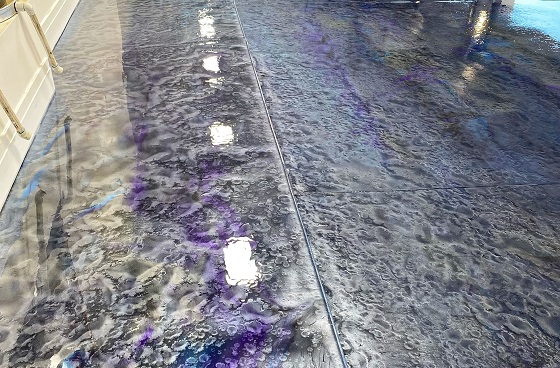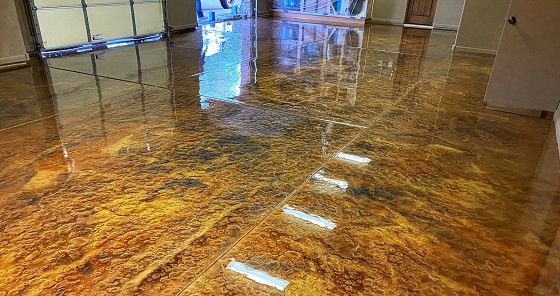Over the past 25 years, I have learned a lot in the decorative floor coatings industry.
One of my greatest successes has been that I am the one who created the metallic epoxy flooring movement. I was so fascinated with the endless possible outcomes and the fact that this type of application is 100% abstract art. I decided to stop offering flake floors and had my website redesigned to showcase and market only metallic solutions. I devoted seven years of doing nothing but my metallics and really trying to understand all the advantages, disadvantages, and ways of manipulating the product and finding out what exactly a metallic floor is. So what did I find?
The Science Behind the Metallics
Metallic floors are abstract art; they are not an exact science. That means that there are literally endless possibilities on how these floors could be installed.
Metallic floors use binders of pigment disbursement. When the floors are done correctly, they look absolutely amazing. When they’re done by someone who has no artistic skills or who doesn’t understand that these skills need to be used, they look as though somebody accidentally kicked over a bucket.
The Future of Metallics
The biggest problem now with metallic floors that I see is that they are headed in the wrong direction. Many installers now who offer them don’t understand anything about them, don’t understand the pros and cons, and don’t understand that these floors are abstract works of art.

No one explains product capabilities, nor do they have the product knowledge. This is not specific to one manufacturer; it is a problem regardless of what type of system is being installed. In addition, the newer generation of installers have really gotten into the metallics because they’re selling a pretty picture to the customer, but that is it. The pretty picture — and in some cases what turns into a not-so-pretty picture — is only used for marketing. It’s an empty promise because there’s zero product knowledge, no explanation of expectations, and in the end, it’s the consumer who is getting screwed.
I am extremely worried that metallics are headed in the wrong direction because of this lack of installer knowledge and education.
A Big Problem
The number one destruction to the industry and a common lie that I see when it comes to metallic floors is how they’re being installed in garages.
Epoxy is not ultraviolet (UV) radiation protected, and it scratches extremely easily. Metallic floors are the worst system that a customer could ever have installed in his or her garage. Customers have been told that as long as the contractor installs a polyaspartic clear topcoat over the metallic floor, this problem will be solved. This false information is not just coming from contractors; it’s also coming from distributors who are charging contractors for classes. For some reason, people buy into the lie and don’t actually do the research. In reality, when polyaspartic clear goes over a metallic floor, the topcoat allows UV rays to go through the clear, and it oxidizes. This turns the bottom layer yellow.
Additionally, metallic floors are seamless, which means that once you patch a scratch, you have now broken the seam. Patching scratches is only a Band-Aid.
As a result, the contractor is installing a system that is not only expensive but not a good fit for this application. Because the customer has no understanding about his or her metallic floor, he or she doesn’t know that what is being delivered is only a pretty picture — and one that won’t last long. With zero UV radiation protection, within a short period of time, the floor will be all scratched up, fading or yellowing, and disappointing.
This isn’t information I’ve gathered just from my own experiences and research. I get many direct messages through Instagram from other coating application companies around the world asking me questions about metallics. The commonality of this problem confirms my point.

The Future of Metallic Floors
After more than seven years of personally installing metallic floors, my company has now officially retired this type of coating solution from our range of offerings. Now that I understand them so well, I do not want to disrespect or sell a lie to any of my customers.
Now, I spend a lot of time on a monthly basis answering phone calls from past customers of mine and others who paid for a metallic floor, and all they do is complain. Their metallic floors are yellow, they scratch easily, and, in general, these have turned into floors that are just completely nonfunctional. They are hiring us now to remove the existing metallic floor and install 100% solid polyaspartic ½" (1.3 cm) and 1" (2.5 cm) flake floors.
Be sure you’re offering a solution that will meet the needs of the customer now and in the future. The only time a metallic floor should be installed is for a commercial environment that is only going to see foot traffic — nothing more.
After 24 hours, when the metallic floor is dry, I recommend a minimum of four layers of wax. The reason why you never want to wax a garage floor is because as soon as you pull a vehicle in, the hot tires would instantly melt the wax. The wax will protect the floor from the UV rays and any scratches that may occur. The wax will help ensure that the only scratches that do happen are in the wax and not in the actual coating of the floor. And then leave your customers with a maintenance plan to re-wax and buff the floor.
My recommendation is to do that as often as you would wash your car, or quarterly.
Final Thoughts
I completely understand why companies are now really pushing for the metallics. They can really boost your profit margin, but in the meantime, you may be selling a lie to your customer. Is that who you really want to be?
I decided it wasn’t who I wanted to be — even after starting the metallic movement, devoting seven years of my life to it, and installing more than 4,000 floors. Retiring my proprietary metallic floors was sad for me, but it also took a lot of weight off my shoulders. It’s allowed me to sleep better at night and not have to worry anymore about the next phone call or if I will run into a previous metallic customer who is unhappy with the floors that I left them with.
In the end, a little education can go a long way.
Editor’s note: This article first appeared in the May 2023 print issue of CoatingsPro Magazine. Reprinted with permission.